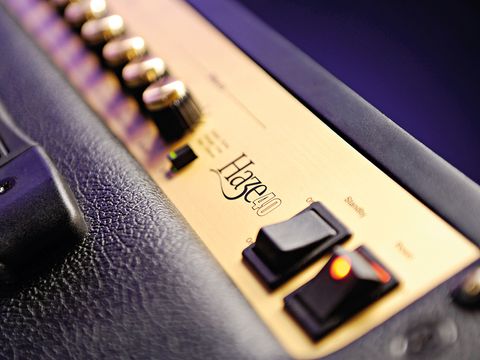Amp titan Marshall may be best known for those towering stacks but the company has periodically produced tasty little amps too. The new Haze series is designed to offer a sensible range of real-world features in compact packages to meet our rehearsing, recording and small gigging needs.
This Haze MHZ40C is a 40-watt 1 x 12 combo that runs on a pair of EL34 output valves. It is a two-channel design; 'normal' handles clean to crunch, and 'overdrive' goes from crunch to higher gain. The combo also has an additional boost function that works in both channels.
According to Marshall's R&D designer James Marchant, this boost changes the overdrive stage from a clipping- to a saturation-style character, courtesy of a clever bit of bias adjustment.
Boost
The amount of boost is considerable but it's fixed, so your guitar's volume control is all-important in achieving the texture and response you like best from the boosted mode.
If you go for the optional Haze Footcontroller (£39), the boost is also footswitchable, giving you four basic sounds at your feet. The standard, included switch is a two-button unit that changes channel and switches the effects on and off. The MHZ40C also boasts a global three-band EQ section with an additional presence control.
This combo comes with a collection of digitally created effects that are designed to retain a good deal of analogue warmth and feel. The emulated spring reverb has its own pot and can be switched completely out of the circuit if you so desire.
In addition you have a choice of vibrato (vibe, orange), delay (echo, green) and chorus (red) courtesy of a push-switch that changes colour to indicate the effect selected. The adjust pot changes an effect's parameter: delay time from short slapback through to 1000ms; vibrato depth and chorus depth.
Effects settings
One cool thing about the effects section is that each channel 'remembers' its effects settings. So, for example, you can set up a clean tone with a bit of reverb and chorus, then switch to a no-reverb overdrive sound with delay in channel two.
Until you physically switch off any of the effects, they'll always be there in that specific channel: neat. One minor downside is that there's a short but noticeable delay when switching channels due to the relays used. The pay-off is that switching is silent with no pops or clunks.
Marshall has gone to the trouble of incorporating speaker-emulated line-out and effects loop options into the combo.The loop is a simple series affair, so pedals and units with their own level controls work best, while the line out offers a direct feed straight to a desk or mixing console. It's not as realistic as a sympathetically mic'd speaker, but it's immeasurably better than a dry, non-EQ'd DI.
The combo is in a sensibly sized, rear-ported box; not so small that the tone is boxy, but not too big that it won't fit in the back seat of the car, or indeed in the boot along with a modest pedalboard, leads bag and two gigbags.
Sounds
There's enough clean headroom in the normal channel for funky chord parts and single-note lines to cut through the mix in a sensible pub band. The bottom end remains tight, with a fairly hard treble and punchy mids: very Marshally clean, you might say, and quite different from the bloomy, chimey openness of Fender's ubiquitous Hot Rod Deluxe.
Upping the volume brings in a certain edge, but if you want crunch from the normal channel, it's better to use the boost function; it's not entirely unlike a well-opened JCM800 in fact, with a sizzley classic rock crunch.
Here, the slight hardness apparent in the clean voice comes into its own by keeping things focused and able to cut through, while still sitting in a band mix. In many people's minds this is what Marshalls were 'for' in the pre-JCM900 days, and also where the aforementioned Hot Rod Deluxe struggles somewhat.
The overdrive channel introduces, as you'd expect, more distortion. It ranges from a light drive that sounds a little weaker than the clean channel's crunch mode, through to a tight (in a good way) distortion that keeps the notes cutting through.
This isn't a metal monster, not least because of its 1 x 12 format, and even with the boost switch engaged, it always feels slightly more classic rock than modern metal.
Cranked up, the power section begins to sag a little, although it retains the EL34's relatively tight bottom end to provide good note separation. If you want super-smooth and creamy Santana-style distortion, just add a distortion pedal of your preference.
The effects are dead easy to set up, and Marshall should be credited for their all-round quality and ease of use. Some may wish for more control over parameters such as delay decay, but the settings offered make sense in most classic rock and pop applications. It's a boon to have them at your fingertips, but it's worth asking whether some players would trade this versatility in for better quality cabinets and a variable boost.
Overview
Compact, mid-powered valve workhorses are the amps most of us use, most of the time. With the Haze 40 combo, Marshall is offering a no-nonsense classic-voiced 1 x 12 package that many would argue has been absent since the venerable JCM800 4010 combo of the eighties.
Until now there was a surprising lack of good value, Brit-flavoured alternatives to Fender's Hot Rod and Blues Deluxe stalwarts. Cost concessions put clear water between these and the big M's low-power Handwired models, but compared with amps in their price bracket there's a great deal here to like.

